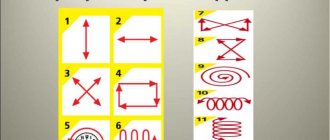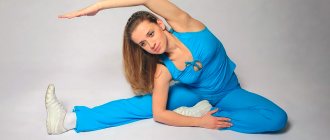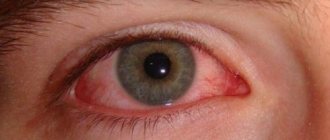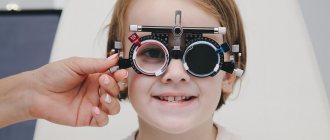- Universal exercises to preserve vision
- Norbekov's technique
Perfect vision is the dream of many. In fact, almost anyone can keep it for life. It is enough just to constantly perform gymnastics for the eyes. Everyone can learn simple sets of exercises. Finding time to study is also not difficult. You only need 5-10 minutes a day.
Benefits and contraindications
Eye exercises for cataracts have the following beneficial effects:
- headache relief;
- relieving dizziness;
- improvement of blood microcirculation;
- activation of cellular metabolic processes;
- general strengthening effect.
Eye exercises are contraindicated for conjunctivitis and blepharitis, as this leads to the spread of infection. You should not perform exercises if you have a retinal detachment, otherwise your vision may deteriorate. Also, eye exercises are contraindicated immediately after surgery.
Solarization
Light has a healing effect on vision. It has been proven that using it as an element for preventing the condition of the visual system is an effective approach. Of course, it is better to use natural light from the sun, but if this is not possible, then lamps can also be useful. The essence of the exercise is to look at the light source through your eyelids. You need to take a position so that the rays fall on your eyes, after closing your eyelids, you need to try not to squint, gradually getting used to the bright light. Then slowly turn your head so that the impact is uniform and versatile. Be very careful when sunbathing; under no circumstances should you look at bright light with your eyes open, as you can damage the retina, especially if it has pathologies.
After the exercise, it is recommended to perform palming. This approach is used during rehabilitation after surgery to restore visual function. Solarization promotes tissue regeneration and normalizes blood circulation.
Tibetan gymnastics
The Tibetan technique allows you to reduce the rate of cataract development. Basic exercises include:
- Regular eye massage is performed every 3-4 hours;
- rapid blinking is performed for 1-2 minutes;
- the eyes close tightly and the eyelids open, the eyes remain wide open for 5-6 seconds;
- the gaze focuses on a near object for 5 seconds, then on a distant one;
- Light pressure is applied to the bridge of the nose, temples, and the area above the eyebrows, followed by tapping with the pads of the fingers.
Examples of eye exercises
Universal exercises to preserve vision
Do you want your vision to remain clear for a long time? Perform simple gymnastics, which includes exercises such as:
- Closing your eyes. Sit on a chair and close your eyes. Open your eyelids. Repeat the exercise 8 times at intervals of 5-10 seconds. A simple complex will strengthen the muscles and at the same time relax them, as well as improve blood supply to the eyes.
- Blinking. This exercise is performed for 1-2 minutes and is aimed at improving local blood supply.
- Shifting your gaze. While standing, look first to the left and then to the right. Move your gaze from bottom to top. The simplest actions train the eye muscles. By performing them regularly, you can prevent a decrease in visual acuity.
We recommend combining exercises with massage. Gently massage the upper and lower eyelids with finger pads. When massaging the upper eyelid, move from the inner edge to the outer, and the lower - in the opposite direction. The session lasts only 1-2 minutes, but allows you to effectively relax the muscles and stimulate blood flow along with the necessary nutrients.
Exercises for recovery from myopia
Myopia is a common visual defect. With this pathology, the image is formed in front of the retina. For this reason, a person sees well near, but poorly at a distance. In the initial stages, you can get rid of the problem. It is enough to do the following exercises:
- Rapid blinking with strong squeezing of the eyelids. Open and close your eyes through resistance. Repeat steps 5-10 times.
- Eights. Make movements with your eyes while drawing the number “8”.
- Verticals, horizontals, diagonals and circles. Draw straight lines and other shapes. Keep your range of motion as wide as possible, but do not strain your eyes.
- Pressure. Place your index fingers on your eyebrows and lift them up. Repeat the exercise 10-12 times.
Exercises to restore vision with farsightedness
Farsightedness is also a common pathology. During the disease, the image is formed not on the retina, but behind it. As a result, patients perfectly see objects located in the distance, but cannot concentrate on objects that are literally in front of their eyes. This often leads to anxiety, headaches and even depression. For this reason, gymnastics should be aimed at relaxation.
We recommend doing the following exercises:
- Pendulum. Swing the pencil, the shaft of which is located at the level of your nose, in different directions and follow the object.
- Candle. Exercises with light and darkness are among the most effective for farsightedness. Conduct classes in a darkened room. Just watch the flame, either facing it or sideways. Don't take your eyes off the fire.
- Letters. Place a dot on your nose (use bright colors, eye shadow, mascara or lipstick for this). Move your nose without closing your eyes, outlining all the letters one by one.
- Surveillance. This exercise is performed on the street or balcony. Select any moving object and simply follow it with your eyes. You can watch a bird, an airplane, a child.
- Tilts. Close your right eye. Tilt your head towards your shoulders. Now close your left eye. Repeat the exercise.
To restore vision in case of farsightedness, you should also massage the eyebrows. It will allow you to fully relax. Place your fingers on your eyebrows. Make soft and leisurely circular movements. Give this massage only 1-2 minutes a day. You will probably notice the first results within a week. They will manifest themselves in improved overall well-being. You will be better able to concentrate on objects that are nearby.
Exercises to relieve tension
Have you already been diagnosed with vision problems? Want to prevent them? We offer a set of exercises that are useful both in the prevention of pathologies and in their treatment.
- Near and far. Focus either on close or far away objects. It is better to perform gymnastics in open spaces. In this case, you will be able to select objects at a sufficiently far distance and concentrate as much as possible while looking at them.
- Figurines. Draw various shapes (circles, squares, etc.) with your eyes.
- Relaxation. We have already described this exercise above. It is called palming and consists of relaxing open eyes in complete darkness, which is achieved thanks to one’s own palms closed over the nose. We recommend not just distracting yourself from problems, but presenting a certain picture. Remember your summer vacation at sea, scroll through frames from your favorite movie in your head, or just turn on pleasant background music. Try to penetrate your own feelings, record positive emotions, enjoy the warmth of your hands.
Perform this simple complex for vision at least once a day.
Exercises for children
Often vision begins to deteriorate at an early age. This is why it is important to visit the ophthalmologist regularly with your child. An experienced doctor will not rush to “put” glasses on the baby (unless there are serious indications for this). Usually, a set of exercises is prescribed to improve vision in the early stages of myopia. Of course, getting a child to study is not so easy. That is why we recommend turning the complex into an enjoyable and interesting game.
How to do it? It's simple! Eye gymnastics to improve vision should:
- Spend it in a pleasant environment. Do not distract your child from games! Invite him to do gymnastics when he is free (after lunch, for example, or immediately after waking up and washing his face).
- Perform in company with toys. Use them as objects for your baby to focus on.
- Carry out regularly. Include activities to improve vision into your baby's daily schedule.
Explain to your child the purpose of the exercises. Talk about how important it is to have good vision. Tell them that the class will allow you to take off your glasses (if you are already using them) or not wear them at all.
Be sure to praise your child while stimulating him. Experts do not recommend giving candy or other sweets as reward. So the child will study only for the sake of treats! In fact, the baby should understand the benefits of exercise.
How often should you exercise? It is enough to perform the vision complex for 3-4 minutes 2 times a day. The training time can be increased. Make sure your baby doesn't rub his eyes. If your child has any complaints, contact an ophthalmologist. This way you will definitely not harm your eyesight. Let's get started?
- Ask your child to blink his eyes like a butterfly flaps its wings.
- Sit opposite your baby and pick up his favorite toy. Ask your child to follow your movements. Move the toy in your hands right and left, up and down.
- Ask your child to imagine a large wall clock and watch the imaginary hand move across the dial. Voice out the numbers the baby represents.
- Ask your child to look at his nose and imagine that it is growing and becoming long, like Pinocchio's. This way the child will move his gaze forward.
- Just make funny faces with your baby. Ask your child to pretend to be an animal or bird, actively moving his eyes.
Gradually teach your baby to be independent. At the age of 8-10 years, he should perform the vision complex without your participation. All you have to do is monitor the correctness of all actions from time to time. To assess the degree of vision restoration, visit your doctor at least 1-2 times every six months. If necessary, he will complement the complex or adjust it. If you perform all the steps correctly, your vision will really improve.
get advice from an ophthalmologist about the effectiveness of eye gymnastics
and also learn about the effectiveness of gymnastics specifically for you
Go
Norbekov method
Gymnastics for the eyes for Norbekov’s cataracts involves a combination of general physical exercises, work with the eye muscles, oriental massage, auto-training and self-hypnosis. Using fine motor skills of the fingers during a massage, overall calm and concentration are ensured. Massage of reflexogenic zones is quite effective - in the center between the eyebrows, on the temples and pits. You need to exercise in a positive mood, moving from less complex exercises to more complex ones.
Regular eye exercises, combined with proper nutrition and vitamin intake, have a positive effect in the initial stages of cataracts.
Before performing exercises, you should consult a doctor. The Clean View clinic provides a full range of procedures for successful cataract removal. We will help you choose a lens and advise on all issues. More details by phone.
Basic methods of vision restoration
Today, there are several methods for restoring vision. Let's look at the basic ones and study the exercises that are included in the complexes of popular authors.
Norbekov's technique
The author of this technique is Mirzakarim Sanakulovich Norbekov, who does not have a medical education! This should be taken into account when performing exercises. We strongly recommend that you first consult with an ophthalmologist when performing gymnastics.
Recovery “According to Norbekov” is based on physical and psychological aspects. It implies:
- gymnastics,
- auto-training aimed at improving the emotional state of the patient.
Norbekov’s position is that only a person who perceives himself as healthy and happy can achieve healing.
The set of exercises developed by the author provides a fairly gentle effect on the visual organs. When performing gymnastics, you should not experience any discomfort.
To achieve maximum effect from exercises, Norbekov recommends:
- follow the sequence of actions;
- perform the complex not only with eyes open and closed, but also mentally;
- tune in to achieve the desired result;
- carry out all actions only in high spirits.
Norbekov’s gymnastics are quite simple. It includes 7 exercises:
- Track with your eyes the movements of an imaginary object, first from bottom to top, and then from top to bottom.
- Move your eyes from left to right and right to left. Imagine that your gaze passes first through your left and then through your right ear.
- Mentally draw various shapes with your gaze. Don't forget to blink regularly. Perform vigorous actions for centuries.
- Draw an imaginary vertical figure eight with your eyes. Make sure that the virtual number does not extend beyond the contours of your face. Alternate directions regularly. Remember to blink after each repetition.
- Concentrate on the tip of your nose. Look ahead of you. Don't move your eyes, but try to look at objects on the sides. Fix your gaze alternately in front of you, on your nose, in the corners of the room, or on specific objects located on either side of your face.
- Bring your index fingers to your nose. Concentrate your gaze on them. Now spread your fingers. Don't lose sight of them.
- Imagine a large clock in front of you. Take a look at the contours of the dial. Try to focus on each number. Perform eye movements first in one direction and then in the other direction.
Zhdanov's technique
The author of the method is Vladimir Georgievich Zhdanov. He also does not have a medical education, but often calls himself a professor. In his opinion, numerous vision problems are caused by malfunctions of the muscular system of the eye.
The gymnastics he proposed are similar to the exercises developed by Bates at the beginning of the last century. According to Zhdanov, simple techniques will help cope not only with myopia, but also with other common pathologies.
All exercises should be performed with 6-10 repetitions. The whole complex will take you 10-15 minutes. Gymnastics includes:
- Eye movements up and down.
- Moving your gaze from right to left.
- "Drawing" diagonal lines.
- Frequent blinking.
- Focusing the gaze on the bridge of the nose, on a close object, on an object located in the distance.
- “Drawing” with the eyes of eights and dials.
Particular attention in Zhdanov’s technique is paid to palming. This exercise allows you to effectively relax. You need:
- Sit at the table in a comfortable position.
- Place your elbows on the surface.
- Place your palms tightly together and close your eyes with them.
- Open your eyelids in absolute darkness.
- Sit for 2-3 minutes.
While palming according to Zhdanov, you should detach yourself from everything that is happening around you.
Tibetan technique
In the East, human eyes are associated with wood and the color of grass.
Adherents of the technique recommend it to office workers, schoolchildren and students and advise:
- Place a green object on your desktop and carefully examine it regularly.
- Surround yourself with plants.
- Several times a day, perform an eye massage, which consists of stroking the eyelids.
- Take 5-minute breaks from work every hour and devote them to gymnastics.
The advantages of the proposed eye exercises include:
- ease of implementation (you can practice not only at home),
- minimum time costs.
The complex includes the following manipulations:
- First, place your index fingers at arm's length from your face. Gradually spread them apart and follow your fingertips with your eyes.
- Now focus your gaze on your fingertips, and then move it as far as possible. Focus on an object in the distance. Fix your gaze on your fingers again.
- Slowly close your eyes, but don't squint. After this, gently press on the eyelids with your fingertips.
- Close your eyes and open your eyelids. Look ahead for a while. At the same time, try not to blink for at least a few seconds.
- Look ahead of you. Now look to the right, then to the left, down and up. Repeat the exercise several times.
- Blink for a couple of minutes.
In the Tibetan method, special attention is paid to washing the eyes. It should be carried out in cold water. If necessary, you can even add ice to it. Pour water into a large, shallow bowl (a large cup will do). Lower your face. Open your eyes underwater and look in different directions. Repeat the exercise at least 10 times. After such washing, the face should be rubbed with a terry towel to stimulate blood circulation.
Book “The Experience of a Fool or the Key to Insight”
It is better to read the book and form your own opinion. With a harsh title, the author criticizes himself and sick people for missed opportunities in restoring health. Has a negative attitude towards laziness and lack of desire to help oneself restore vision.
There are approximately equal numbers of supporters and opponents of the technique. This is greatly facilitated by M. Norbekov’s lack of a medical diploma.
The book offers the interested reader an introduction to the healing method. Instructions on physical exercises are provided, their expediency and practical significance are explained.
Some advice is intended to support a person’s self-affirmation and eliminate indecision and lack of will. Of course, the book is interesting for many readers, even for preventive purposes, and the author deserves gratitude for his work.
Training our memory
Our eyes only read information; we actually see objects with our brain. The psyche and vision are closely related processes, and memory is one of the main mental functions of the brain. It is no coincidence that we perceive objects that we remember better; our brain instantly completes the image, without spending a lot of time on recognition, as is the case with unfamiliar objects.
Hence the importance of training our memory. A memorization exercise is a kind of memory simulator. Choose an object, take a good look at it, and then try to mentally reconstruct the picture in detail. It must be performed without correction means. The subject can be figures, inscriptions, pictures - anything that will be interesting and useful for you to remember.
Focusing on sensations
Norbekov forbids practicing in a sad mood and is an ardent opponent of laziness. Great importance is attached to understanding the importance of exercise, listening to your feelings, connecting attention to the feeling of coldness, warming, numbness in different parts of the body.
Along with physical improvement, personal growth occurs. The author claims that after a course of gymnastics, a person’s spiritual mood changes, self-confidence appears, and many managed to achieve professional success.
On the subject: Vitamins for the eyes - which are the best?
Author biography
Mirzakarim Sanakulovich Norbekov is one of the famous Uzbek and Russian alternative healers. His homeland is a mountain village near Samarkand. Born in 1957, he grew up in a large family.
He studied fine arts and began working on wall painting. He was drafted into the army into the construction troops. Here he was seriously injured. He achieved his cure with the help of his own willpower and constant exercise. He became a convinced activist and developer of physical exercises to combat various diseases.
Since the 90s, together with other devotees (L. Fotina, Yu. Khvan), he has created a number of organizations teaching people self-healing. Actively promotes a healthy lifestyle among the population and personal development.
In 1998, he opened the Institute of Human Self-Healing in Moscow and became its director. Classes using his method are held here. The first writing experience began with the publication of a book in 2001, then several more printed publications were published. Since 2010, he has been the President of his own.
M. Norbekov takes part in programs on various television channels and is published in magazines.
The Institute has representative offices in 28 countries and 14 branches in the USA. The methods proposed by M. Norbekov are very popular.
Experts draw attention to the “pseudoscience” of the author’s views. This is due to Norbekov's unclear role in attracting thousands of people. There is information about the use of hypnotic influence and subjugating techniques.
There is no reliable information about the author’s academic degrees, education, or sports awards. Verification attempts do not confirm Norbekov’s participation in karate competitions.
Nevertheless, such an odious fame for the author adds to his popularity.
How to eat to see well
Poor nutrition is the most important factor in the development of various diseases, including visual pathologies. First of all, of course, you should adhere to the general recommendations of proper nutrition:
- Minimize everything fried, smoked, salty, excessively fatty, and sweet.
- Do not eat large quantities of semi-finished products and industrially preserved food.
- Eat in small portions, but often. The last meal should be 2-3 hours before bedtime.
- Eat fruits and vegetables in season.
Eating certain types of foods is also beneficial for the eyes. These include carrots and pumpkin (rich in carotene), parsley, fish containing large amounts of vitamin A (sardine, salmon, tuna), and seaweed. Vitamin C, contained in rose hips, cherries, cherries, peaches and apricots, also has a healing effect. Corn, beans, and broccoli strengthen the retina. Don’t forget about cereals and various cereals.











